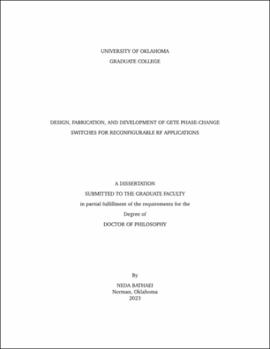| dc.description.abstract | This research is devoted to studying the chalcogenide phase change material (PCM) properties and their potential capability in RF switching applications. The goal of RF switches would be to realize the reconfigurability and adaptability of RF and microwave systems. The current RF switches are primarily based on solid-state and, more recently, micro-mechanical technologies. Each has limitations like integration compatibility, cost, reliability, or power handling. In the beginning, PCM was employed almost exclusively in non-volatile memory usage. However, PCMs exhibit properties that can improve the current state-of-the-art RF switches, like high contrast between electric conductivity in their two stable states. This means switches with low loss and high isolation subsequently translate to high cutoff frequency (fCO).
Another feature that is very suitable for RF systems is PCM switches’ very low power consumption. They require power only during state changes and can keep their state since both crystalline and amorphous phases are stable at room temperature. Among all chalcogenide PCM compounds, germanium telluride (GeTe) has features like fast switching speed and low resistivity in
the crystalline state, which makes it the best candidate for RF applications. This work presents the study of GeTe growth, crystallization, and design of RF switches utilizing it. A novel, physical vapor deposition (PVD) method called pulse electron-beam deposition (PED) was experimentally studied to investigate the requirements for the ablation of GeTe. It will be discussed
that the as-grown GeTe is amorphous and why the initial crystalline state is preferred. In order to convert the GeTe thin film into a crystalline formation, post-treatment annealing was performed. To optimize the post-annealing procedure, several annealing parameters were experimentally investigated. The thin film resistivity dropped by six orders of magnitude upon the crystallization
process. The crystallized GeTe thin films were investigated by contemplating the crystallite quality and the electrical conductivity performance. In the following, the design and fabrication of RF ohmic switches, as well as the challenges and solutions, are discussed in detail. Also, PCM-based RF switches are modeled to perceive their behavior better. | en_US |
